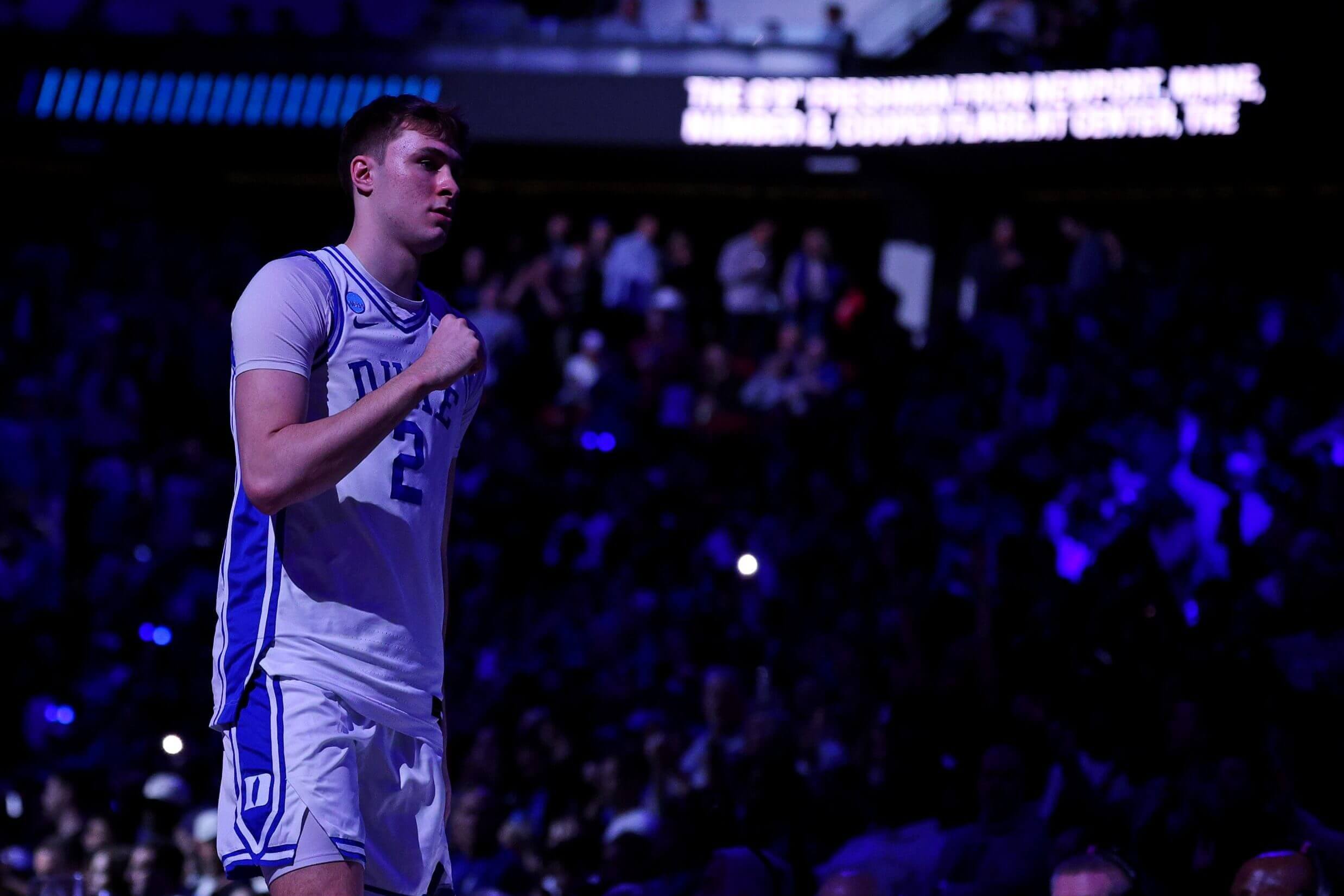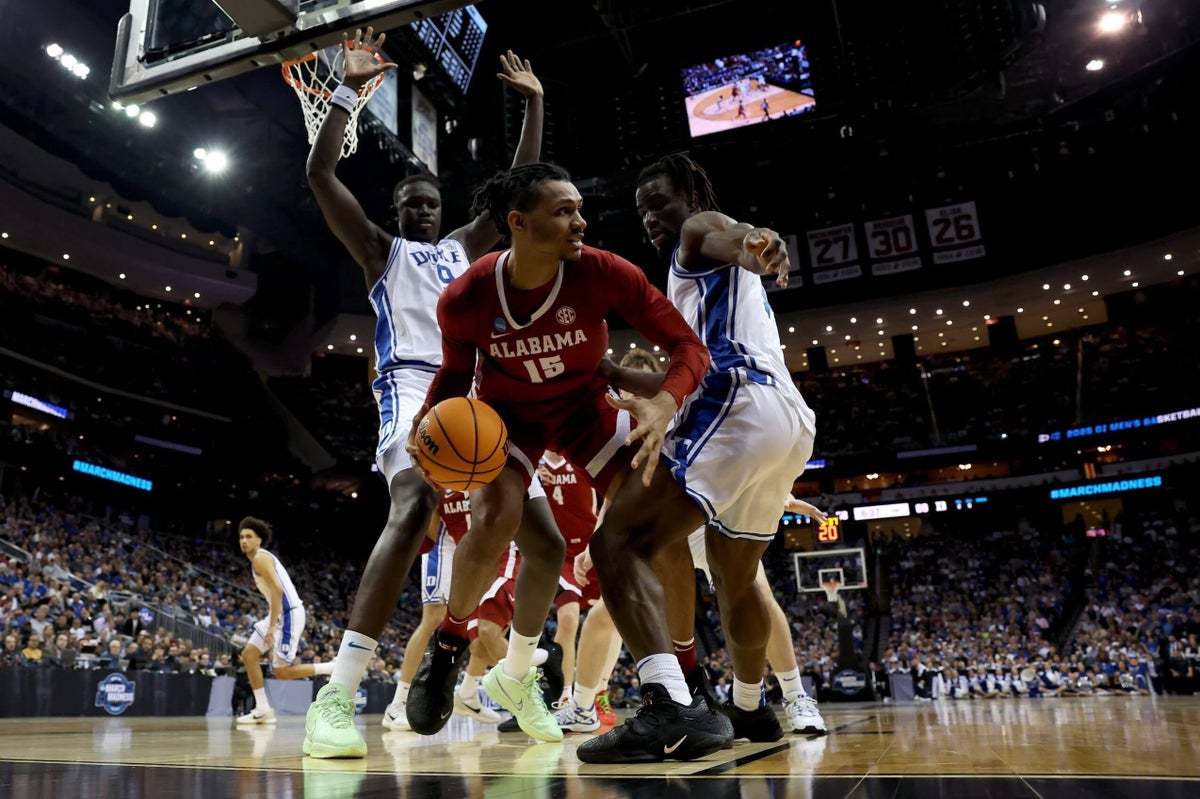Duke Advances to the Final Four with a Dominant Performance Against Alabama

NEWARK, N.J. — With just 6:39 remaining, Duke found itself on the brink of a Final Four appearance, a goal they had relentlessly pursued all season. Head coach Jon Scheyer gathered his team, took a deep breath, and delivered a crucial message. What he said during that pivotal media timeout could determine the game’s outcome: either propel the Blue Devils to San Antonio or mark a significant misstep in his tenure.
“It’s our time, right f—ing now. Right f—ing now!” Scheyer emphatically declared to the five players before him. “This is our game.” And soon, it became exactly that.
Following that timeout, Alabama managed to score a mere seven points. The Crimson Tide, boasting one of the most potent offenses Duke faced all season, had previously executed a historic offensive showcase just two days prior. In sharp contrast, Duke accelerated its gameplay, expanding a nine-point lead into a commanding 20-point advantage, ultimately winning 85-65. Kon Knueppel led all scorers with 21 points, while star freshman Cooper Flagg contributed 16 points, nine rebounds, and three assists, earning the title of East Region Most Outstanding Player.
Despite his accolades, Flagg had an off night by his standards, shooting 6-of-16 from the field, with four turnovers marking his highest since a January game against Wake Forest. Yet, that’s where teammates like 7-foot-2 center Khaman Maluach — who scored 14 points and grabbed nine rebounds — and Knueppel stepped up, showcasing the depth of the squad. “Everybody just coming into their role, doing their own, and just doing their job,” Flagg noted. “That’s what’s got us here.”
With this victory, Duke secured its 18th Final Four appearance, the first since 2022 and Scheyer’s inaugural as head coach. Previously, he celebrated national titles as a player in 2010 and as an assistant coach in 2015. The Blue Devils now await the winner of Sunday’s South Regional final between Houston and Tennessee. They became the second No. 1 seed to earn a spot in the Final Four, following Florida’s earlier achievement on the same day.
That timeout was the turning point. “It can either be a game and all of a sudden, they’re on your heels — or you can get that extension,” Scheyer reflected in an interview with The Athletic from the depths of the Prudential Center. “We’ve talked a lot about the inflection points. … Sometimes when you think about it as an eight-minute game, you don’t treat the precious possessions the way you should at that moment. That’s what I was trying to convey.” Clearly, the message resonated.
“We realized we had to dig down deep and get more stops,” said Maluach. “Keep on getting stops, and then try to eliminate fouls that put them on the line so that the clock stops, and minimize 3-pointers.”
Duke executed all of the above during the final seven-minute stretch, demonstrating the prowess of the nation’s fifth-best defense (as ranked by KenPom’s adjusted efficiency metrics). Alabama’s next nine possessions post-timeout yielded four missed layups, three turnovers, and a lone missed free throw, before guard Mark Sears managed to score a free throw with 2:47 remaining, cutting Duke’s lead to 19. That effectively sealed the game.
“We had a shot there. I think it was a nine-point game with the under-eight media,” said Alabama coach Nate Oats. “Then they went on a 13-0 run — and that was it.”
In many respects, Duke’s defensive display in the closing minutes mirrored their overall excellence throughout the season, propelling them to ACC regular-season and tournament titles, as well as the No. 1 ranking and seed in the East Regional. With only a maximum of 80 minutes left in the season, their defensive strategy could very well lead Scheyer’s team to a sixth national championship banner.
Flagg managed to score 16 points against Alabama, but the Blue Devils didn’t require more from their star freshman, who had lit up the scoreboard with 30 points in the Sweet 16 victory over Arizona. (Vincent Carchietta / Imagn Images)
Reflecting on the situation, it seems almost naïve to have doubted Duke’s defensive capabilities. Faced with Alabama’s offensive onslaught on Thursday against BYU, the pressing question was whether Oats’ high-octane team could be contained. Alabama, after all, had set an NCAA Tournament record with 25 three-pointers in that Sweet 16 game, displaying a rhythm reminiscent of their Final Four run last season.
Yet, Alabama’s dismal shooting performance — finishing the game with a 23-for-65 (35.4 percent) field goal rate and an abysmal 8-for-32 (25 percent) from beyond the arc — became just another chapter in Duke’s journey to San Antonio. Oats’ squad, which averaged 13.7 fast-break points per game — ranking 18th nationally according to CBB Analytics — was restricted to a mere eight points on fast breaks throughout the game.
It was evident that Scheyer and his staff emphasized this aspect, as his message resonated in nearly every huddle: “Get our asses back, play our f—ing pace and do what you do.” You can only imagine how many times that mantra echoed within Duke’s program during the intense 36 hours leading up to the Elite Eight showdown. “I don’t even know what the outside of New Jersey looks like,” assistant coach Emanuel Dildy remarked. “We’ve been holed up in the hotel ballroom. Constant meetings, constant staff discussions, constant team huddles… but at least we’re still playing.”
Despite the game’s high-profile billing, it appeared early on that Duke would dominate. Flagg sank a top-of-the-key three-pointer on the very first possession, igniting a 15-5 run out of the gate for the Blue Devils. While Alabama eventually settled in, that initial lead proved critical, allowing Duke to maintain a 46-37 advantage at halftime.
Duke entered the game averaging 94 points across their first three tournament outings, and they struck first. With little resistance, they shot 56.3 percent in the first half, matching Alabama’s five three-pointers but on ten fewer attempts: nine compared to Alabama’s 19.
If Sears had been hitting at his usual rate, the game might have taken a different turn. However, Duke’s array of defenders stifled the All-American, limiting him to a scoreless first 17:43 of the contest, during which he also recorded three turnovers. Sears finally managed a mid-range shot moments before halftime, but it was clear that Duke’s length — the tallest team in the nation according to KenPom, with no players shorter than 6 feet 5 — played a significant role in stifling Alabama’s offense.
“It’s not really something that we haven’t done before,” noted Duke guard Caleb Foster. “Contest every shot, don’t get strung out too far, and don’t get riled up if they hit a few.”
There’s a reason why Scheyer and his close friend, Boston Celtics general manager Brad Stevens, agreed on the best philosophy for building a college roster during the preseason: there’s no substitute for length.
As Duke took the court for the second half, Flagg’s mother, Kelly, expressed what Duke fans across the nation were undoubtedly feeling: “100 more minutes, that’s all I want.” With a 20-point lead at stake, only 40 minutes remained — and perhaps another 40 for the championship.
When Alabama opened the second half hitting just 1-for-7, failing to chip away at the deficit, it became evident that Duke’s confetti cannons were poised to erupt. Even as Duke encountered offensive hurdles at times in the second half, their ability to reach the free-throw line consistently kept Alabama at arm’s length. They finished the game shooting 19-for-22 from the line, including an impressive 14-for-16 in the second half.
Alabama never got within six points in the second half, and even that was thanks to their own free-throw success; Oats’ team shot ten of their total fourteen free throws during the second half. That’s why, in that same huddle with 6:39 remaining, Scheyer’s primary reminder was straightforward: “They are automatic free-throw shooters.”
Alabama managed just one more free throw for the remainder of the game: Sears’ lone point, when the outcome was already determined.
In contrast, Duke’s game-sealing 13-0 run following that critical media timeout was punctuated by Flagg’s floater in front of the Duke bench. Now, the Blue Devils stand just two games away from achieving college basketball immortality.
(Top photo of Alabama’s Jarin Stevenson and Duke’s Sion James and Khaman Maluach: Elsa / Getty Images)

